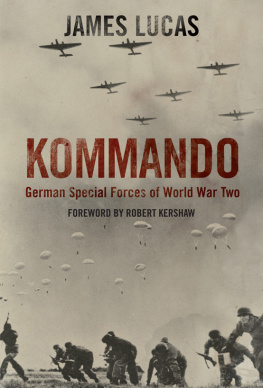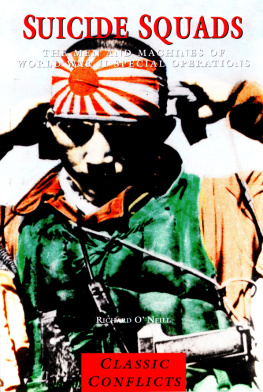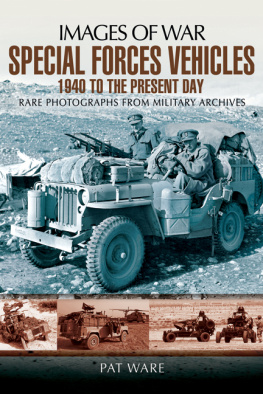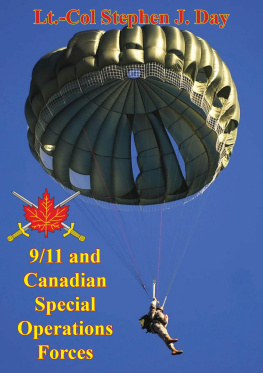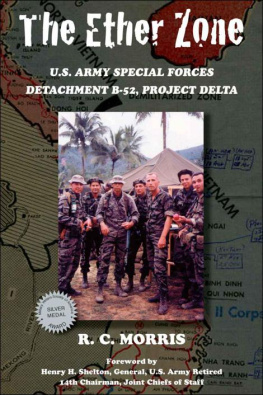KOMMANDO
German Special Forces
of World War Two
KOMMANDO
German Special Forces of World War Two
James Lucas
Foreword by Robert Kershaw

Frontline Books, London
Kommando: German Special Forces of World War Two
This paperback edition published in 2014 by Frontline Books

an imprint of Pen & Sword Books Ltd,
47 Church Street, Barnsley, S. Yorkshire, S70 2AS
www.frontline-books.com
Copyright James Lucas, 1985
Foreword Robert Kershaw, 2014
The right of James Lucas to be identified as the author of this work has been asserted by him in accordance with the Copyright, Designs and Patents Act 1988.
ISBN: 978-1-47383-461-3
Publishing History
First published by Arms and Armour Press, London, 1985.
All rights reserved. No part of this publication may be reproduced, stored in or introduced into a retrieval system, or transmitted, in any form, or by any means (electronic, mechanical, photocopying, recording or otherwise) without the prior written permission of the publisher. Any person who does any unauthorized act in relation to this publication may be liable to criminal prosecution and civil claims for damages.
CIP data records for this title are available from the British Library
For more information on our books, please visit
www.frontline-books.com, email info@frontline-books.com
or write to us at the above address.
Printed and bound by CPI Group (UK) Ltd, Croydon, CR0 4YY
Contents
LIST OF DIAGRAMS
James Lucass book Kommando, about German Special Forces during the Second World War, was first released in 1985 and has stood the academic test of time well. Ever since the Franco-Prussian war of 1870, when French franc tireurs attacked German lines of communication across the Rhine, the German Army harboured an antipathy toward guerilla fighters. Irregular fighters were considered deceitful and fighting in civilian disguise unfair. The German soldier considered himself the honourable defender of the Fatherland. There was no place for counter-insurgents who, during colonial conflicts in Africa and during the First World War were shot out of hand.
As a consequence the development of German Special Forces during the Second World War was one of implicit disapproval towards such unconventional forces. The pre-war German Reichswehr disapproved of the evolution of the Fallschirmjger (parachute) arm. Control was relinquished to the Luftwaffe, which controlled all its potential resources in any case. Parachute troops were dismissed as too lightly armed, and the German Army shared the international contemporary view, that they were unlikely to operate effectively in a hostile air environment. Special forces in the modern sense, parachute or marine raiders, held little attraction.
Following the Soviet example demonstrated during mass parachute landings at an exercise in Kiev in 1935, Gring, the head of the German Luftwaffe, decided to transform a crack Prussian paramilitary police unit, the Wecke detachment at Berlin, into the first German parachute unit. Oberstleutnant and later General Student, who had seen the impressive Soviet exercise, was entrusted with its future development. The dilemma was should the newly formed parachute troops be employed as raiders, or as the army preferred, advance units dropped ahead of a ground force linkup. Student creatively favoured the concept of independent air landings at the operational level. For this, a complete airborne division with one Fallschirmjger regiment and two air-transportable regiments of light infantry would be required. The conundrum of how to deliver heavy weapons alongside them was solved by the advent of the military glider. These were heavier machines able to carry anti-tank weapons and artillery, designed to descend over distance rather than soar for height like the sport variants. A German airborne division was developed in secret on the eve of the Second World War.
The massive scale and extent of the parachute landings that preceded the German blitzkrieg through Fortress Holland in 1940 was unprecedented. The Allied armies were shocked by the ease with which the Belgian fort at Eben Emael fell to a glider assault. In August 1914 it had taken 60,000 German troops eleven days to batter the frontier Belgian forts into submission. On 10 May 1940 just over 400 paratroopers flying in 48 transports towing 42 gliders captured the bridges and Eben Emael in an hour. It appeared special forces were capable of capturing strategically vital operational objectives.
The Assault Group Koch that captured Eben Emael transitioned into a full Sturm glider and parachute assault regiment as part of an expansion of a German Airborne Corps. The corps was to be decimated the following year during the airborne invasion of Crete, the only time a strategic objective was ever to be captured by air alone. The Sturm Regiment lost 70% of its 1,860 men, while the 7th Flieger Division was reduced from nine to three and a half battalions. Hitler stopped any further development of his airborne capability.
For the rest of the war the Fallschirmjger divisions and corps were employed as elite infantry, fire-brigade troops shoring up threatened fronts. Only raids and reinforcements at between company to battalion level were conducted by parachute and glider. The Italian dictator Mussolini was rescued by a spectacular glider landing next to the hotel where he was being interned, at the Gran Sasso Italy in July 1943.
A battalion level glider assault was also mounted against Titos partisan headquarters at Drvar in Yugoslavia on his birthday in May 1944, but he escaped. Glider insertions were also made prior to the punitive German operation to clear the French Marquis from the seemingly impregnable Vercors plateau the following July, after D-Day.
Lucas correctly describes the inept nature of German spying and espionage. There were inspirational leaders such as Admiral Wilhelm Canaris, who took over the Abwehr in the Reich War Ministry in 1935. Canaris was much travelled and regarded as a born spy by Himmler, the head of the SS. Intelligence networks and staff increased ten-fold under Canaris, but their autonomy and full potential was circumscribed by competing organizations, namely Reinhard Heydrichs Sicherheitsdienst or SD, the secret service arm of the SS. Heydrich was dubbed the blond beast by his subordinates and proved a duplicitous and relentless adversary until his assassination in 1942. Canaris became increasingly disillusioned with the Nazi hierarchy and was eventually implicated by the SD and dismissed from office in February 1944. He was arrested after the assassination attempt on Hitler in July and was to be hanged one month before the end of the war.
German military intelligence, distracted by these patch disputes, became increasingly unreliable as the war progressed. Lucas accurately describes its amateur operations at the beginning of the war and the bungling nature of the intelligence preparations backing Operation Sea Lion, the projected invasion of Britain in 1940. German intelligence estimates of the Allied garrison prior to the disastrous invasion of Crete were understated by a remarkable three-fold factor of error. The Fallschirmjger were briefed that there would be no Greek troops on the island and that the Cretan population was pro-German. Estimates of Soviet strength prior to the invasion of Russia were even worse. A potential Russian strength assessment of 200 divisions was hastily revised to 360 within two months of the invasion. The much maligned crumbling workers paradise unexpectedly fought back with technologically superior tanks with sloping armour. T-34 and KV tanks, which had never been seen before, were much heavier and completely out-gunned the panzers. After the appointment of Oberstleutnant Reinhard Gehlen in April 1942 to head the intelligence for Foreign Armies East, assessments improved. The Soviet winter counter-offensive in 19412 was completely missed, so was the sudden reversal following the debacle at Stalingrad the following winter.

